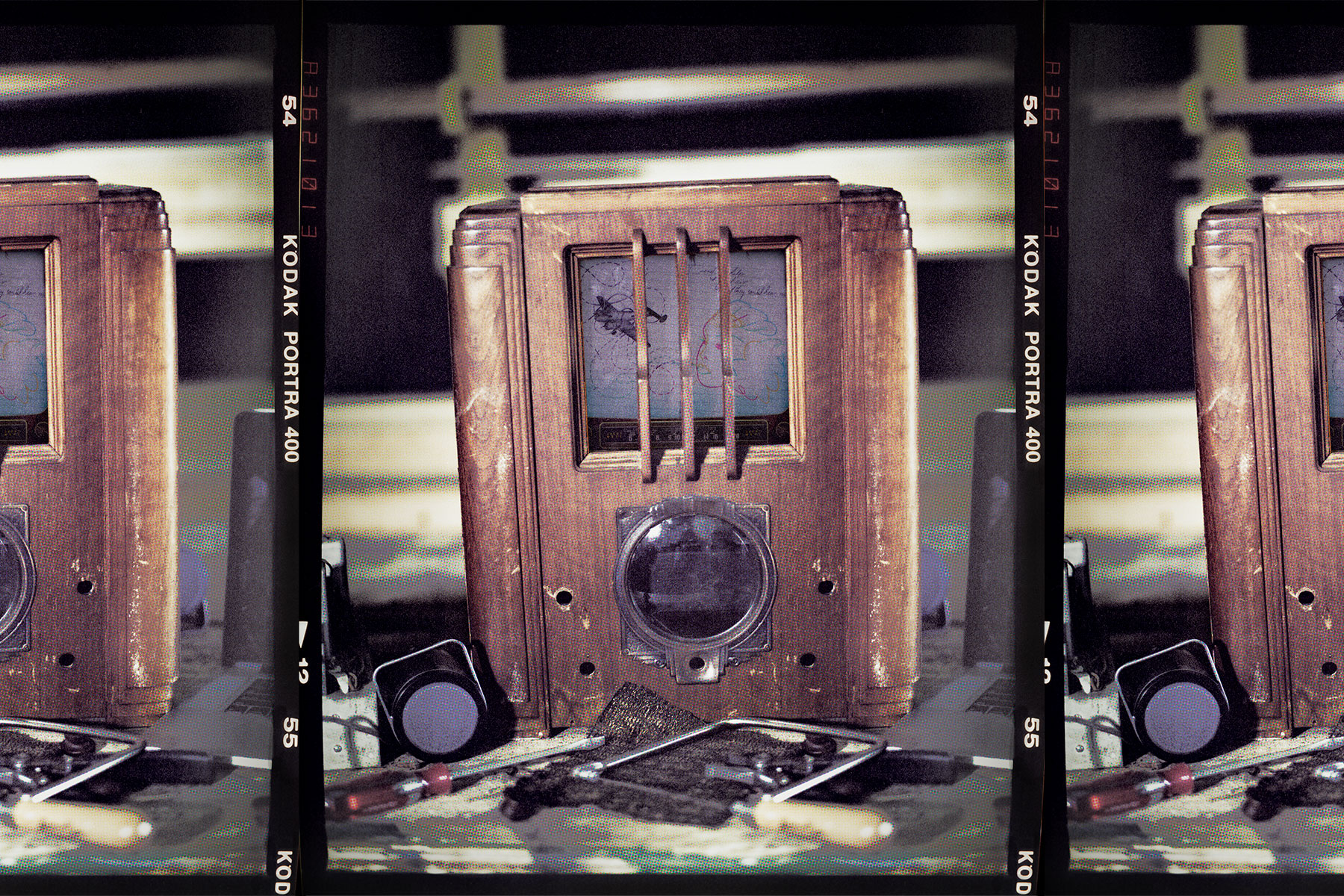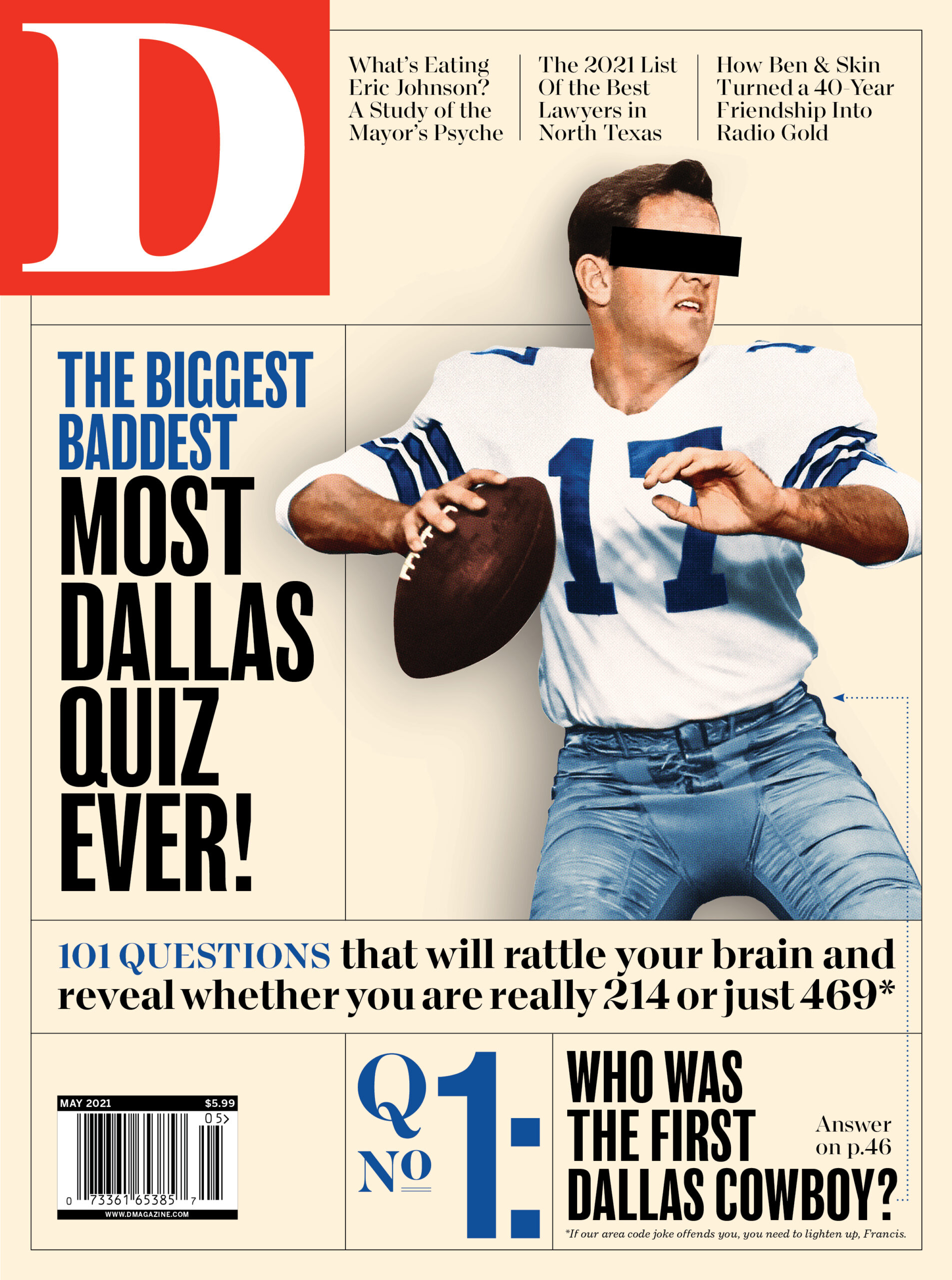Bart McGeehon is putting the finishing touches on a vintage 1930s radio outfitted with an LCD screen and refitted speakers in his light-filled Bishop Arts District loft. He’s the production manager of the AT&T Performing Arts Center, and he does freelance work as a set and lighting designer. But at the moment, he’s completing his transformation of the retro specimen into the sole physical embodiment of an art object whose dynamic reality will exist entirely in the etheric, intangible world of blockchain technology.
This is the latest endeavor from Verdigris Ensemble, a choral group led by founder and artistic director Sam Brukhman. Verdigris is proposing to catapult itself—and choral music in general—into the nascent realm of programmable music that can be auctioned, resold in cryptocurrency, and modified by its user-owners. It will not just be cutting edge; it will be the first of its kind, propelling Dallas onto the international crypto art scene.
Last fall, the 28-year-old Brukhman connected with Async Art, the San Francisco-based company that recently had a coup with the sale of Block 21, one of a 40-piece series created on the company’s platform by Ben Gentilli, the London-based artist known as Robert Alice. The canvas disc, hand-painted with a portion of the digits that made up Bitcoin’s launch code (the full series contains all 12.3 million digits), sold last October for more than $131,000. It was the first artwork associated with a nonfungible token (NFT), a sort of digital key stored in the blockchain for authenticity, to be auctioned by Christie’s. In March, the digital artist known as Beeple sold a wholly digital art piece for $69 million. And earlier this spring, Alice’s Block 21, along with Beeple’s latest work and other heavyweights of blockchain art, was part of the first crypto art exhibit, held at Beijing’s UCCA Lab, a division of the UCCA Center for Contemporary Art.
At this point, the crypto art arena is like a soda bottle shaken up and ready to explode. And its next logical outlet is music and video. Async, co-founded by gamers and artists, has distinguished itself since February 2020 by providing a platform that allows its artists not just to mint final digital products, but to make layered, programmable—that is, interactive—artwork that shifts according to the owner-user’s choices. Preparing to launch Async Music in late April or May, the company wanted Verdigris to represent the classical music genre, alongside work by punk, hip-hop, and electronic and house artists. Async is positioning itself as a potential juggernaut, hoping to slip into the stream as pioneers of programmable music in what could become an expanding field.
The piece it chose, “Betty’s Notebook”—a work that centers on Amelia Earhart’s purported final distress calls as captured by 15-year-old Floridian Betty Klenck on her father’s shortwave radio and recorded in her notebook—is already layered. Verdigris originally performed the piece, composed by Texas-born Nicholas Reeves, in 2019. It’s a haunting palimpsest of electronic distortions, jazz standards, interferent crackling noise, and Earhart’s own words.
This is how it will become a piece of crypto art: fifteen masked singers, under the guidance of Brukhman and producer Anthony Maglione, meticulously recorded the tracks in a studio in Far North Dallas. Async’s programmable model then allowed Verdigris to extricate and put back together the dense audio layers. Four changeable layers, each composed of three distinct-sounding MP3s minted into unique NFTs by Async, will be stored on the blockchain. These four tracks can be bought and sold as units, and their owners can manipulate them to sound one of three ways.
A fifth version housed in the old radio, the master, will contain all four layers and allow its owner to experience—but not control—each of the shifting sound layers, as well as accompanying imagery. For example, one layer contains the distress calls of Earhart sung by the choir and is accompanied by a graphic of a page with scribbled inscriptions, referencing Klenck’s notebook.
Think of it like a quartet of DJs remixing various tracks. And as the sound of one layer becomes menacing or more delicate, the quicksilver states effect changes in the visuals. The master-in-the-sky owner of the radio will bear witness to the audio manipulations as images are broadcast on the screen.
“We have been conditioned to listen to music in a very linear way,” Brukhman says. “Press play, OK. [Elements] play in tandem, start to finish. But we’ve never considered listening to music based on the components.” This project does exactly that.
Whoever buys the old radio will own the single complete copy of the Verdigris album. And while the owner of the whole can choose to make the album available online, ownership will be tracked using NFTs. The proof of scarcity and verified ownership built into NFTs, which are retained when works are resold on the cryptocurrency art market, also mean secondary royalties can be created through built-in smart contracts for artists, allowing them to retain rights to their work after it leaves them and appreciates in value. In the case of Async, the company currently offers the artist 75 to 90 percent royalties on the primary sale and 10 percent royalties on subsequent sales.
For Verdigris, the whole business of the avant-garde is not new. They came onto the scene in 2017, performing vocal work in the UTA planetarium and setting David Lang’s stirring “Little Matchbook Girl Passion” to dance with Avant Chamber Ballet in their first season. By season two, they were invited to join the ferociously innovative Bang on a Can All-Stars to sing Julia Wolfe’s 2015 Pulitzer Prize-winning “Anthracite Fields” for the Soluna music festival.
The choral group digs a paradigm shift. But they had to achieve this project incredibly fast, corralling a team that included a composer, a conductor, a sound mixer, and singers into a tight three- to four-month process.
New York-based graphic designer and animator Bryan Brinkman, who designed the visuals for the project and has made Emmy Award-winning work as part of the visual effects team for Saturday Night Live and as a graphic artist for NBC’s The Tonight Show Starring Jimmy Fallon, says, “It’s been wild to see the space break mainstream during the process. We were on the niche side of this.” Now he overhears people talking about NFTs in furniture stores on the weekend. “It’s no longer just deep in the internet.”
Although his career is anchored in TV and animation, Brinkman has done pop-culture art gallery shows and has always dabbled in digital art. “A little over a year ago, I discovered this subculture of crypto artists,” he says. “In the past, I had been creating digital art and turning it into physical art, whether screen prints or 3D or shadow box art. I was always starting digitally and finding a way to make it physical so I could sell it.” But crypto art opened up a whole new world of creative possibilities and virtual canvases. “I became more interested in what could be done with this technology that couldn’t be done outside of it,” he says.
He sees a future in which we live entwined with augmented reality, “not full-time, but interacting in that space, so you’ll be wearing augmented glasses and you’ll have digital art on your wall and that digital art will all be owned with NFTs. And so you’ll be able to decorate your house in a way that is dynamic and unique. And other people that come into your space will see those things, and you’ll be able to share this art.”
A crypto artist with a sizable following, Brinkman has already seen the financial benefits. A piece he sold for $200 resold for $1,000, yielding him an additional $100. Then it sold again, this time for $11,000. He’s now looking at paying off his art school loans, and he has started investing in other crypto artists. For every sale, he converts 30 percent into stablecoin to cover taxes, leaves 60 percent in the cryptocurrency market, and reinvests 10 percent into another crypto artist.
This parallel is part of what drew him to the project to begin with. “We’re all creating a global community,” he says, “and shouting out into the world, and hoping someone sees what we’re creating and it resonates with them.”
Exceedingly collaborative, “Betty’s Notebook” would make choral music interactive in a way that it hasn’t been. Brukhman believes it has the potential to disrupt the whole classical music industry.
“If we’re successful in selling this, it’s going to be revolutionary,” he says. “Not just for Verdigris, but for all classical music organizations.” He’s already had an orchestra reach out to him, wanting to be the first in its lane. “Tell us how to do it,” they said.
Brukhman is hoping to sell the master to a private collector and is talking with galleries in New York, Los Angeles, and Switzerland. With bidding beginning at $150,000, it would outprice the layers, which he imagines will start at $5,000 to $8,000 in a spring Async auction.
Prospective buyers will have other options available as well. Limited editions of platinum, gold, and silver “records” will offer different price points for smaller collectors, like a snapshot or audio single of the work in its current form. “You’re now an investor of sorts,” Brukhman says. “You buy a gold edition and, when ‘Betty’s Notebook’ gets into a museum or wins a Grammy, the value increases significantly. It’s like a stock.”
He can feel himself teetering on the brink of a new reality. For crypto art, for Verdigris, for the classical music world.
“I just see this vision so clearly,” he says, “that the upside is going to be so big for everybody.”
This story originally appeared in the May issue of D Magazine. On Saturday, May 8, Betty’s Notebook sold in an online auction for a combined total of $375,000 (sold in the cryptocurrency ether). This is well over the opening bids and surpasses Brukhman’s initial hopes, as cited above, for something in the range of a combined $175,000. It marks Async Art’s largest single NFT sale. The buyer of the master copy and three layers was Metapurse, the entity that acquired a piece by Beeple for more than $69 million in Christie’s first wholly digital artwork auction in March.
Write to [email protected].






